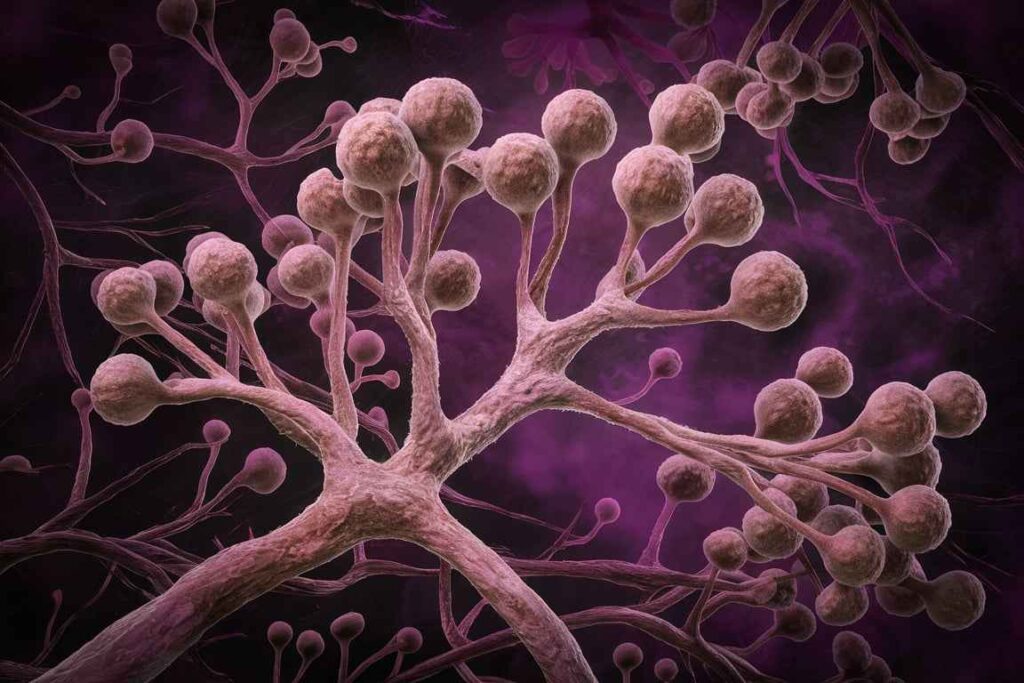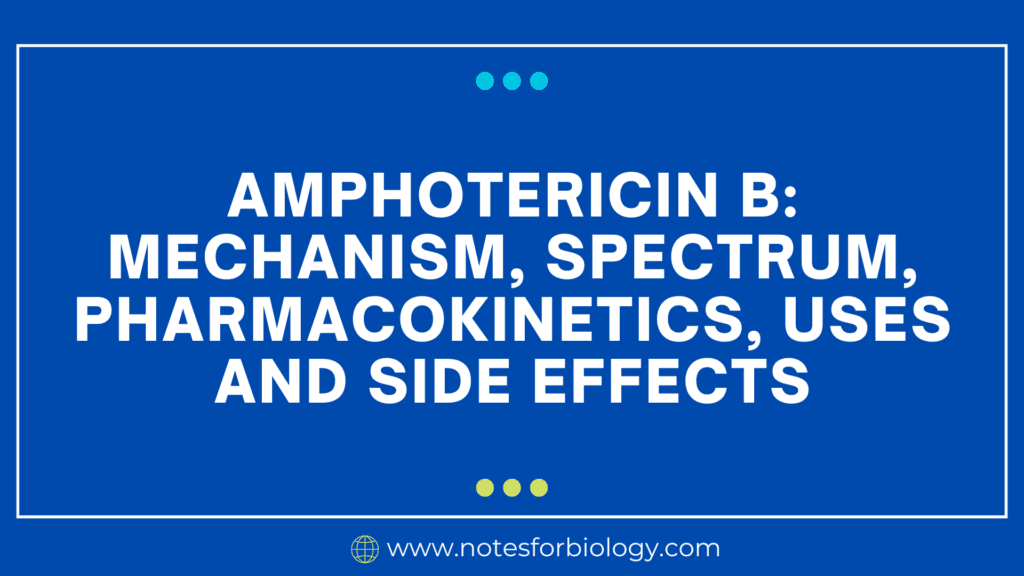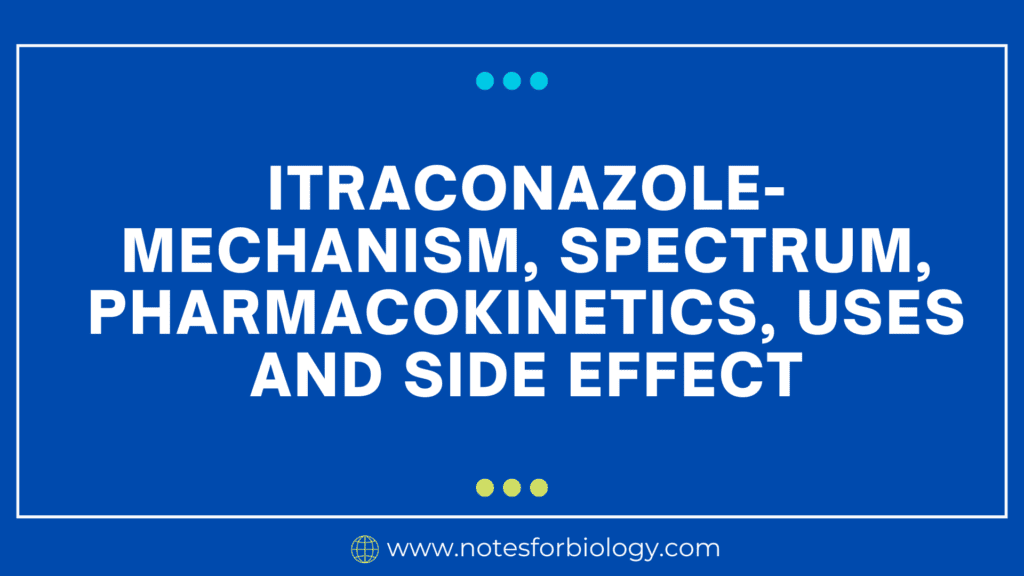Amphotericin B is a broad-spectrum antifungal medication used to treat serious fungal infections. Due to its effectiveness against a wide range of fungi and its fungicidal (killing fungi) properties in certain situations, it remains a cornerstone therapy despite its potential for severe side effects
Table of Contents
Amphotericin B
Amphotericin B is a broad-spectrum antifungal drug. It is still a cornerstone therapy in spite of its serious adverse effect potential because of its efficacy against a variety of fungus and its fungicidal (killing fungi) capabilities in specific circumstances. This mode of action, spectrum of activity, pharmacokinetics, clinical applications, and adverse effects will all be covered in detail in this extensive overview.

Mechanism of Action
This works by disrupting the cell membrane of fungi. Here’s a breakdown of the key steps:
- Target Binding: Amphotericin B, a polyene antibiotic, binds specifically to ergosterol, a sterol component present in the fungal cell membrane. It has a much higher affinity for ergosterol compared to cholesterol, the sterol found in mammalian cells.
- Pore Formation: This binding creates pores or channels within the fungal cell membrane. These pores allow for the uncontrolled leakage of essential electrolytes and cellular components, such as potassium, sodium, and small molecules.
- Cell Death: The loss of essential components disrupts fungal cell function and ultimately leads to cell death.
Spectrum of Activity
It exhibits a broad spectrum of activity against various fungal pathogens, including:
- Aspergillius species (e.g., Aspergillus fumigatus)
- Candida species (e.g., Candida albicans)
- Cryptococcus neoformans
- Mucorales (e.g., Rhizopus)
- Blastomyces dermatitidis
- Histoplasma capsulatum
- Coccidioides immitis
It’s important to note that some fungal strains may develop resistance to it. Regular susceptibility testing is crucial to guide treatment decisions.
Pharmacokinetics:
This is poorly absorbed from the gastrointestinal tract and requires intravenous administration. Due to its complex structure, it has limited distribution throughout the body and does not penetrate well into the central nervous system (CNS). The drug primarily undergoes metabolism in the liver and is eliminated through the feces.

Clinical Uses:
Amphotericin B is reserved for treating severe and life-threatening fungal infections due to its potential for serious side effects. Here are some of its primary clinical uses:
- Invasive aspergillosis
- Candidiasis (especially disseminated or invasive forms)
- Cryptococcal meningitis
- Mucormycosis
- Histoplasmosis
- Coccidioidomycosis
- Blastomycosis

Side Effects:
Amphotericin B is known for its potential to cause severe side effects. These can be categorized as follows:
- Nephrotoxicity: The most common and potentially life-threatening side effect is damage to the kidneys. Regular monitoring of kidney function is essential during treatment.
- Fever and chills: These are frequent side effects that typically occur during or shortly after infusion. Premedication with pain relievers and antipyretics can help manage these symptoms.
- Electrolyte imbalances: Leakage of electrolytes from fungal cells can lead to imbalances in the body’s electrolytes, requiring close monitoring and correction.
- Anemia: Amphotericin B can suppress bone marrow function, leading to a decrease in red blood cell production and anemia.
- Hypotension: The drug can cause low blood pressure, requiring monitoring and potential use of medications to maintain blood pressure.
- Phlebitis: Inflammation of the vein at the infusion site is a common side effect.
Additional Considerations:
- Due to the potential for severe side effects, Amphotericin B should be administered and monitored by experienced healthcare professionals in a hospital setting.
- Several formulations of Amphotericin B exist, including liposomal formulations, which aim to reduce side effects. The choice of formulation depends on the specific clinical situation.
- Close collaboration between physicians, pharmacists, and other healthcare professionals is crucial to ensure safe and effective use of Amphotericin B.
Frequently Asked Question.
What is Amphotericin B?
Amphotericin B is a broad-spectrum antifungal drug. It is still a cornerstone therapy in spite of its serious adverse effect potential because of its efficacy against a variety of fungus and its fungicidal (killing fungi) capabilities in specific circumstances.
What are the side effects of Amphotericin B ?
The side effects of Amphotericin B are
1. Nephrotoxicity
2. Fever and chills
3. Electrolyte imbalances
4. Anemia
5. Hypotension
Related Article
Vitamin A: Structure, derivatives, Properties, Biological roles and deficiency



